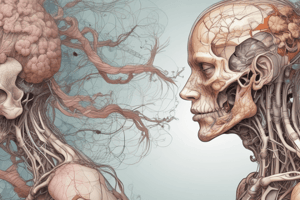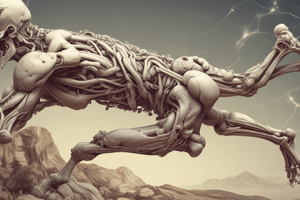Podcast
Questions and Answers
What is the primary function of epithelial tissue?
What is the primary function of epithelial tissue?
- Support and binding
- Communication and signaling
- Protection, secretion, and absorption (correct)
- Movement and locomotion
Which type of bone is exemplified by the femur?
Which type of bone is exemplified by the femur?
- Long bone (correct)
- Irregular bone
- Flat bone
- Short bone
What action does the arrector pili muscle perform?
What action does the arrector pili muscle perform?
- Relaxes hair follicles
- Causes hair loss
- Stimulates hair growth
- Contracts to make hair stand upright (correct)
What are the components of a reflex arc?
What are the components of a reflex arc?
Which part of the brain is mainly responsible for coordinating voluntary movements?
Which part of the brain is mainly responsible for coordinating voluntary movements?
What is the primary function of cerebrospinal fluid (CSF) in the brain and spinal cord?
What is the primary function of cerebrospinal fluid (CSF) in the brain and spinal cord?
Which part of the neuron is responsible for transmitting impulses?
Which part of the neuron is responsible for transmitting impulses?
What is the role of nociceptors in the body?
What is the role of nociceptors in the body?
What is the main difference between endocrine and exocrine glands?
What is the main difference between endocrine and exocrine glands?
Which lobe of the brain is responsible for vision?
Which lobe of the brain is responsible for vision?
What are the primary functions of the integumentary system?
What are the primary functions of the integumentary system?
How does muscle contraction occur?
How does muscle contraction occur?
What is the main function of the epidermis in the skin?
What is the main function of the epidermis in the skin?
What distinguishes the axial skeleton from the appendicular skeleton?
What distinguishes the axial skeleton from the appendicular skeleton?
What is the primary difference between catabolism and anabolism?
What is the primary difference between catabolism and anabolism?
Which of the following is a stage of cellular respiration?
Which of the following is a stage of cellular respiration?
What are the four main types of body tissue?
What are the four main types of body tissue?
What role do pain receptors (nociceptors) play in the body?
What role do pain receptors (nociceptors) play in the body?
Which of the following statements correctly describes the function of cerebrospinal fluid (CSF)?
Which of the following statements correctly describes the function of cerebrospinal fluid (CSF)?
What is the main function of the arrector pili muscle?
What is the main function of the arrector pili muscle?
How do endocrine glands differ from exocrine glands?
How do endocrine glands differ from exocrine glands?
What is the primary function of the cerebellum in the brain?
What is the primary function of the cerebellum in the brain?
What are the main functions of the three parts of a neuron: dendrites, axon, and axon terminals?
What are the main functions of the three parts of a neuron: dendrites, axon, and axon terminals?
Which features distinguish DNA from RNA?
Which features distinguish DNA from RNA?
What is the process of muscle contraction involving actin and myosin filaments?
What is the process of muscle contraction involving actin and myosin filaments?
What are the differences between flexion and extension in joint movement?
What are the differences between flexion and extension in joint movement?
Which parts of the eye are crucial for focusing light?
Which parts of the eye are crucial for focusing light?
Flashcards
Types of Body Tissues
Types of Body Tissues
Epithelial (protection, secretion, absorption), Connective (support, binding, transport), Muscle (movement), Nervous (communication, control)
Bone Shapes
Bone Shapes
Long (femur), Short (carpals), Flat (sternum), Irregular(vertebrae).
Arrector Pili Function
Arrector Pili Function
Causes goosebumps when it contracts in response to cold/stress.
Reflex Arc Components
Reflex Arc Components
Signup and view all the flashcards
Voluntary Movement Control
Voluntary Movement Control
Signup and view all the flashcards
Anatomy vs. Physiology
Anatomy vs. Physiology
Signup and view all the flashcards
Cerebrospinal Fluid (CSF) Function
Cerebrospinal Fluid (CSF) Function
Signup and view all the flashcards
Pain Receptor (Nociceptor) Location
Pain Receptor (Nociceptor) Location
Signup and view all the flashcards
Epidermis & Dermis Function
Epidermis & Dermis Function
Signup and view all the flashcards
DNA vs. RNA
DNA vs. RNA
Signup and view all the flashcards
Neuromuscular Junction
Neuromuscular Junction
Signup and view all the flashcards
Endocrine vs. Exocrine Glands
Endocrine vs. Exocrine Glands
Signup and view all the flashcards
Neuron Parts & Functions
Neuron Parts & Functions
Signup and view all the flashcards
Cell Membrane Function
Cell Membrane Function
Signup and view all the flashcards
Nucleus Function
Nucleus Function
Signup and view all the flashcards
Cytoplasm Function
Cytoplasm Function
Signup and view all the flashcards
Axial Skeleton Parts
Axial Skeleton Parts
Signup and view all the flashcards
Appendicular Skeleton Parts
Appendicular Skeleton Parts
Signup and view all the flashcards
Active Transport Function
Active Transport Function
Signup and view all the flashcards
Passive Transport Function
Passive Transport Function
Signup and view all the flashcards
Catabolism Function
Catabolism Function
Signup and view all the flashcards
Anabolism Function
Anabolism Function
Signup and view all the flashcards
Glycolysis Function
Glycolysis Function
Signup and view all the flashcards
Citric Acid Cycle Function
Citric Acid Cycle Function
Signup and view all the flashcards
Electron Transport Chain Function
Electron Transport Chain Function
Signup and view all the flashcards
Epithelial Tissue Function
Epithelial Tissue Function
Signup and view all the flashcards
Connective Tissue Function
Connective Tissue Function
Signup and view all the flashcards
Study Notes
Anatomy and Physiology
- Anatomy: Study of body structure and organization
- Physiology: Study of how body parts function and work together
Cerebrospinal Fluid (CSF)
- Cushions brain and spinal cord
- Removes waste
- Provides nutrients
Pain Receptors (Nociceptors)
- Sensory neurons
- Located in skin, joints, and organs
- Respond to harmful stimuli
Epidermis and Dermis
- Epidermis: Outermost layer, protects against pathogens and prevents water loss
- Dermis: Strength, elasticity, contains blood vessels, nerves, glands
DNA vs. RNA
- DNA: Double-stranded, stores genetic information, contains thymine
- RNA: Single-stranded, involved in protein synthesis, contains uracil
Neuromuscular Junction
- Nerve impulse triggers acetylcholine release
- Stimulates muscle contraction
Endocrine vs. Exocrine Glands
- Endocrine: Secrete hormones directly into bloodstream
- Exocrine: Secrete substances into ducts (e.g., sweat, saliva)
Neuron Structure and Function
- Dendrites: Receive signals
- Axon: Transmits impulses
- Axon terminals: Release neurotransmitters
Muscle Contraction
- Actin and myosin filaments slide past each other
- Driven by ATP and calcium ions
Integumentary System Functions
- Protection
- Temperature regulation
- Sensation
- Excretion
Brain Lobes
- Frontal lobe: Decision-making, motor function
- Temporal lobe: Hearing, memory
- Parietal lobe: Sensory processing
- Occipital lobe: Visual processing
Cerebellum
- Coordinates voluntary movements
- Maintains posture and balance
Cranial Nerve Example (Optic Nerve)
- Optic nerve (II): Responsible for vision
Joint Movements
- Flexion: Decreases angle between body parts
- Extension: Increases angle between body parts
- Rotation: Movement around an axis
- Abduction: Movement away from midline
- Adduction: Movement towards midline
Eye Focusing
- Lens focuses light onto retina
Cell Structure
- Cell membrane: Regulates what enters/exits the cell
- Nucleus: Contains genetic material, controls cell activities
- Cytoplasm: Houses organelles, facilitates chemical reactions
Axial vs. Appendicular Skeleton
- Axial: Skull, spine, ribcage (protection)
- Appendicular: Limbs, girdles (movement)
Cell Membrane Transport
- Active transport: Movement against concentration gradient, requires energy
- Passive transport: Movement along concentration gradient, no energy required
Catabolism vs. Anabolism
- Catabolism: Breakdown of molecules, releases energy
- Anabolism: Building of molecules, requires energy
Cellular Respiration Stages
- Glycolysis: Breaks down glucose to pyruvate, produces ATP
- Citric acid cycle: Further breaks down pyruvate, produces ATP and electron carriers
- Electron transport chain: Uses electrons to produce large amount of ATP
Body Tissues
- Epithelial: Protection, secretion, absorption
- Connective: Support, binding, transport
- Muscle: Movement
- Nervous: Communication, control
Bone Shapes
- Long bones: Femur, humerus
- Short bones: Carpals, tarsals
- Flat bones: Sternum, ribs
- Irregular bones: Vertebrae
Arrector Pili Muscle
- Contracts to cause hair to stand up (goosebumps)
Reflex Arc
- Sensory neuron detects stimulus, transmits signal to interneuron
- Interneuron sends signal to motor neuron, causing rapid involuntary response
Voluntary Movement Coordination
- Motor cortex in frontal lobe controls voluntary movements via motor neurons
- Cerebellum coordinates smooth execution
Studying That Suits You
Use AI to generate personalized quizzes and flashcards to suit your learning preferences.





